The exhibiting projects generated by the fascinating confrontation with the studio are unusual, nevertheless always distinguished by a depth of analysis, so that they shine in the memory to stimulate the desire for investigation. Such unexpected initiatives place themselves far from current hedonisms, distancing themselves from the substantial temptation that chases the volatile trends of today’s fashion.
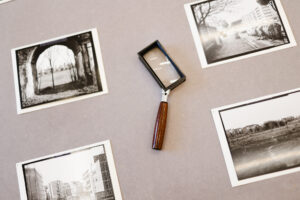
Gilles Raynaldy, Nouveau venu, qui cherches Rome en Rome, ph. Credit Vanessa Caredda, courtesy pianobi, Roma
On this shining research aura we find is the project that Isabella Vitale proposes for her exhibiting space, dedicated to the photographer Gilles Raynaldy (Paris, 1968), demonstrating once again how the reserved moment of analysis is her usual field of affection. The exhibition, curated by Alessandro Dandini de Sylva, entitled Nouveau venu, qui cherches Rome en Rome, and scheduled to run from 26 March to 30 May 2023, is an interesting project that uncovers the importance of archival work, while at the same time revealing a photographic narrative in the open air, thus providing unusual views originating from a dialogue with the city of Rome.
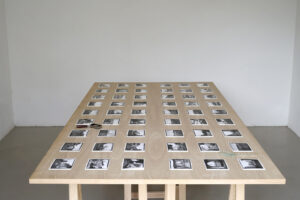
Gilles Raynaldy, Nouveau venu, qui cherches Rome en Rome, ph. Credit Vanessa Caredda, courtesy pianobi, Roma
As evidence of an independent interpretative thought, which is the identifying feature of the exhibitions curated by Dandini de Sylva, you will be surprised by the exhibition preference as it is deliberately anti-exhibitory, being strongly purged and devoid of photographs displayed on the walls. Consistent with this choice, the curator makes the exhibition an invitation to study, with the peculiar positioning of a selection of specimens on white envelopes that can be consulted with magnifying glasses, all neatly arranged on an observation table. This way, the works themselves invite us not to remain passive, leading us to discover unknown destinations and encouraging the discovery of new correspondences through archival methodology.
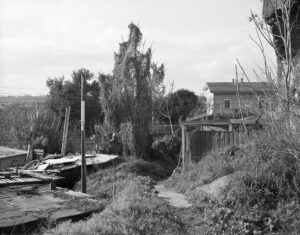
Gilles Raynaldy, Nei pressi al Parco degli Acquedotti, December, 3, 2021, courtesy pianobi, Roma
In spite of their small size, the shots are all characterized by a certain airiness and fullness of light, so that Rome loses its usual geographical boundaries to become a territory of discovery, according to which to look is never to imagine, but rather to fix a certificate of the photographer’s presence[1] in a given place. Thus, for Raynaldy, photography acquires the persistence of a visual sensation, translated according to an acute and balanced sensitivity between light, color and vanishing points that unexpectedly communicate how much his attention falls on the ordinary[2] city foreshortening. The latter is to be understood as a point of observation as a positive suggestion with which to perceive the landscape in a different way, focusing the attention on the measure of the portrayed space.
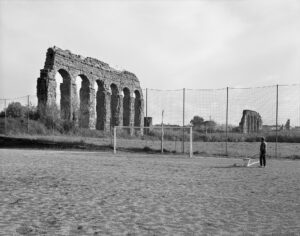
Gilles Raynaldy, Nei pressi al Parco degli Acquedotti, December, 3, 2021, courtesy pianobi, Roma
Raynaldy’s vision is generated by a deliberately anti-triumphalist, meek and shy approach, just like the artist’s temperament. The landscape subject is treated in a delicate, covertly melancholic manner, together with a particular inclination to unearth views of an isolated city, at times deserted and unrecognisable, as in the case of the Park near the Aniene river, enhanced by white reflections in black and white. This procedure sketches a line of research that combines a firm mastery of the camera with a distinctly classical afflatus; the image, in fact, is fixed with the camera obscura, an optical bench capable of impressing plates of ten by twelve centimetres, while not allowing any post-production work, since the digital version is absent. Such creation times are very relaxed, both because of the photographer’s movements from Porta Maggiore to the eastern part of the city – which take place by bicycle – and because of the moment of cognitive encounter with the place as laid bare by Raynaldy. From this process, persuasive places emerge, usually sporadically ‘unseen’, whose sharp light reveals a deliberately objective photographic tendency that exudes a dear sentiment, though never documentary, solidly grounded in a perspective structure with a central or lateral vanishing point.
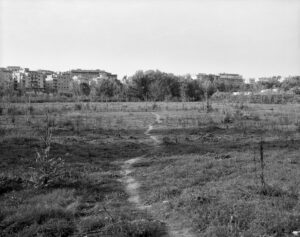
Gilles Raynaldy, Parco vicino Aniene, October, 21, 2022, courtesy pianobi, Roma
It is also evident that Raynaldy’s attention is drawn to the posing of places in which the visual cuts sometimes reveal themselves, while others remain almost deliberately concealed as they lack absolute references. In such contexts, silence envelops the chosen views, giving imaginative space to something elusive that characterizes the photographer’s work, distinguished as it is by a quiet subversive soul. Moreover, the specimens in the exhibition are relevant not only for their tonal relationships, but also for the drives they generate aimed at sharpening the attention towards something specific that the viewer is free to identify, as the eye when reading the image wanders in search of firm references in the landscape. This way, the works are a compendium of relationships in which the points of attraction can be distinguished, one with photographic realism, in other words.
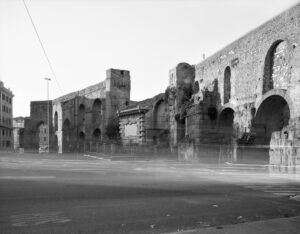
Gilles Raynaldy, Acquedotto Claudio, Porta Maggiore, November 2022, courtesy pianobi, Roma
It is evident that what is on display is in the form of geographical coordinates inviting not only to interpret, as mentioned, but also to follow in Raynaldy’s footsteps, throwing a bridge towards the concrete experience of a landscape far removed from contemporary spectacularization. Indeed, the photographer always succeeds in fixing the wild and softly urban nature with his readings, giving only the clues of a city labyrinth in which, the city is interrogated not for the hedonistic and descriptive pleasure but rather to grasp the more precise trace of its perception.
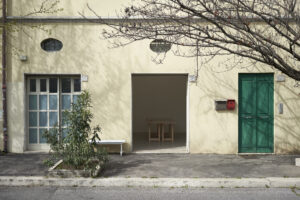
Gilles Raynaldy, Nouveau venu, qui cherches Rome en Rome, ph. Credit Vanessa Caredda, courtesy pianobi, Roma
All this is rendered with the feeling of the place, through the physical objects, the lights, even the sporadic nature of the passers-by, characteristics that communicate the essence of urban spaces. And it is in this fantastic openness of vision, as an operational and research condition, that Raynaldy’s photography and the exhibition choices proposed by pianobi combine, aware that the world is so complex that it invites us to study it: the photographer, to this end, performs the tactile gesture of his fingertips on the shutter button, as if the machinery became an extension of his own body; otherwise, Isabella Vitale renders homage to such artistic forms with the rare ability to draw us to the study, transmitting a singular sense of love and participatory quietness.
[1] Roland Barthes, La camera chiara, Nota sulla fotografia, (1980), Piccola Biblioteca Einaudi, 2016, p. 87
[2] Gianni Celati, Il transito mite delle parole. Conversazioni e interviste 1974-2014, edited by Marco Belpoliti and Anna Stefi, Quodlibet Storie, Letteratura, Lezioni e conversazioni, 2022, p. 563. About the term “ordinary” see the analysis by Cesare Zavattini, according to whom the photographer’s attention by falling on ordinary territories and aspects brings out his own extraordinarily realistic, but also personal reading.
Info:
Gilles Raynaldy Nouveau venu, qui cherches Rome en Rome
curated by Alessandro Dandini de Sylva in collaboration with Isabella Vitale
26/3 2023 – 30/5/2023
pianobi, Via dei Ciceri 97/99, Roma
www.pianobi.info
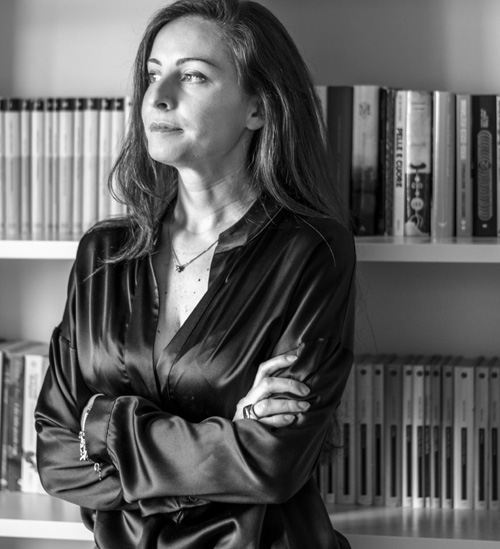
Maria Vittoria Pinotti (1986, San Benedetto del Tronto) is an art historian, author, and independent critic. She currently is the coordinator of Claudio Abate’s photographic archive and Manager at Elena Bellantoni’s Studio. From 2016 to 2023 she was the Gallery Manager in a gallery in the historic center of Rome. She has worked with ministerial offices such as the General Secretariat of the Ministry of Culture and the Central State Archive. Currently, she collaborates with cultural sector magazines, focusing on in-depth thematic studies dedicated to modern and contemporary art.






NO COMMENT